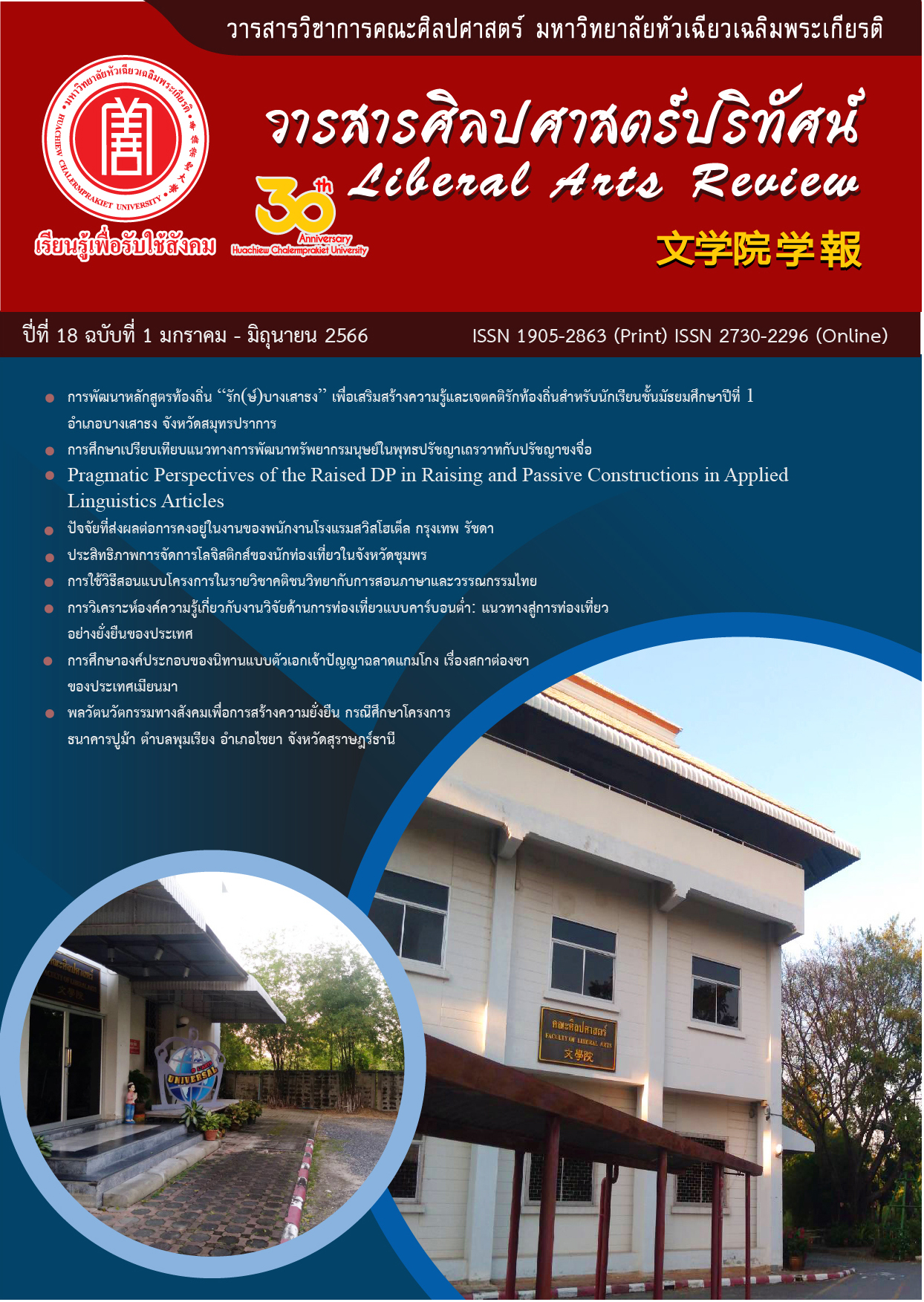A study of the element of Myanmar jest tale with intelligent protagonists cheats Ska tong Sa
DOI:
https://doi.org/10.14456/lar.2023.8Keywords:
Literary Elements, jest tale literature with intelligent protagonists cheats, Ska Tong Sa, MyanmarAbstract
This research article aims to study the elements of Ska Tong Sa, Myanmar jest tale with intelligent protagonists cheats produced by Won Sar Yay U Gyi and published in 1980. The researcher has analyzed elements of the literature through documents and research by using the conceptual framework for the study of literary elements. The purpose of the composition is for entertainment and morality. The format of the story is a prose narrative, punctuated by dialogue and references to other literary works. The content and sequence of events in the story opens with a narrative scene, progresses according to the life calendar style, the critical point of the story, The unfolding of the story. The character creation consists of Ska Tongsa, Nga Lat To, Nga Nyo, with all protagonists having an intelligent cheater personality. The characters are also presented by the narrator as a guide. The composer creates realistic scenes that appear in Myanmar. The author's point of view is revealed through the character's dialogue, the author uses the ancient Myanmar language and uses rhetoric to accompany the story in which the use of rhetoric is found in parables, stylistic metaphor and the main rhetoric.
References
กัญญรัตน์ เวชชศาสตร์. การศึกษาเปรียบเทียบเรื่องศรีธนญชัยฉบับต่าง ๆ ในเอเชียตะวันออกเฉียงใต้ (วิทยานิพนธ์อักษรศาสตรมหาบัณฑิต). จุฬาลงกรณ์มหาวิทยาลัย, กรุงเทพมหานคร.
กุณฑิกา ชาพิมล มาโนช ดินลานสกูล และ นิดา มีสุข. (2559). องค์ประกอบของวรรณกรรมเยาวชนประเภทบันเทิงคดีที่ได้รับรางวัลชนะเลิศรางวัลหนังสือดีเด่นของสำนักงานคณะกรรมการการศึกษาขั้นพื้นฐานรางวัลแว่นแก้ว และรางวัลนายอินทร์อะวอร์ดระหว่างปีพุทธศักราช 2546-2555. กรุงเทพมหานคร: คณะมนุษยศาสตร์และสังคมศาสตร์ มหาวิทยาลัยทักษิณ.
จิรธัตริ์ เรืองเขียน และบุญช่วย สนสี. (2563). ประโยชน์ของวรรณคดี : กลวิธีการสร้างตัวละครในวรรณกรรมกับการใช้ประโยชน์เชิงการสื่อสารที่ปรากฏในการทำงานและการใช้ชีวิตจริง. ศิลปศาสตร์ปริทัศน์, 15(2), 204-214.
นพดล จันทร์เพ็ญ. (2534). การใช้ภาษาไทย. กรุงเทพมหานคร: แสงศิลป์การพิมพ์.
บุญญาภา คำผาง. (2552). การศึกษาคุณค่าเชิงวรรณศิลป์จากนวนิยายเรื่อง คำอ้าย ของ ยงค์ ยโสธร (วิทยานิพนธ์ปริญญามหาบัณฑิต). มหาวิทยาลัยนเรศวร, พิษณุโลก.
วนิดา บำรุงไทย. (2543). ศาสตร์แบะศิลป์แห่งนวนิยาย. พิษณุโลก: สำนักพิมพ์มหาวิทยาลัยนเรศวร.
วาสนา เกตุภาค. (2521). คติชาวบ้าน. กรุงเทพมหานคร: สหสยามพัฒนา.
เสาวลักษณ์ อนันตศานต์. (2548). นิทานพื้นบ้าน (พิมพ์ครั้งที่ 2). กรุงเทพมหานคร: สำนักพิมพ์มหาวิทยาลัยรามคำแหง.
อุบลรัตน์ พันธุมินทร์. (2548). งะแล็ดโต่ งะโหญ่และสกาถ่าวซา ศรีธนญชัย (ฉบับเมียนมา). มนุษยศาสตร์สาร, 6(2), 62-75.
နေဘုန်းဝေ. (n.d.) စကားတောင်စားနှင့်ငလတ်တိုငညိုဟာသရသဝတ္တုများ. ရန်ကုန်, မြန်မာ ပင်မြင့်မာလာပုံနှိပ်တိုက်.
လောကသစ္စာ. (2019). စကားထောင်စားငလတ်တိုငညို(ဟာသဉာဏ်စူး စကားထူး). ရန်ကုန်, မြန်မာ စိုးမေတ္တာပုံနှိပ်တိုက်.
မြေလတ်သိန်းလွင်. (1972). စကားတောင်စားငလတ်တိုငညို. ရန်ကုန်, မြန်မာရတနာဂုဏ်ရည်စာပေ.
လာတ်မိုးဆွေ.(2012).စကားကပ်သည့်အရာ၌စံထားရသူချည်ပါသားနှင့်ပခန်းသားပါဝင်သော စကားတောင်စားဝတ္တု. ရန်ကုန်, မြန်မာ သိန်းထွန်းပုံနှိပ်တိုက်.
ဝန်စာရေးကြီး. (1980). စကားတောင်စားဝတ္တု. ရန်ကုန်, မြန်မာ ဒွေးပုံနှိပ်တိုက်.
Downloads
Published
How to Cite
Issue
Section
License
Copyright (c) 2023 Liberal Arts Review

This work is licensed under a Creative Commons Attribution-NonCommercial-NoDerivatives 4.0 International License.
บทความที่ได้รับการตีพิมพ์เป็นลิขสิทธิ์ของวารสารศิลปศาสตร์วิชาการและวิจัย
ข้อความที่ปรากฏในบทความแต่ละเรื่องในวารสารวิชาการเล่มนี้เป็นความคิดเห็นส่วนตัวของผู้เขียนแต่ละท่านไม่เกี่ยวข้องกับมหาวิทยาลัยหัวเฉียวเฉลิมพระเกียรติ และคณาจารย์ท่านอื่นๆ ในมหาวิทยาลัยฯ แต่อย่างใด ความรับผิดชอบองค์ประกอบทั้งหมดของบทความแต่ละเรื่องเป็นของผู้เขียนแต่ละท่าน หากมีความผิดพลาดใดๆ ผู้เขียนแต่ละท่านจะรับผิดชอบบทความของตนเองแต่ผู้เดียว




